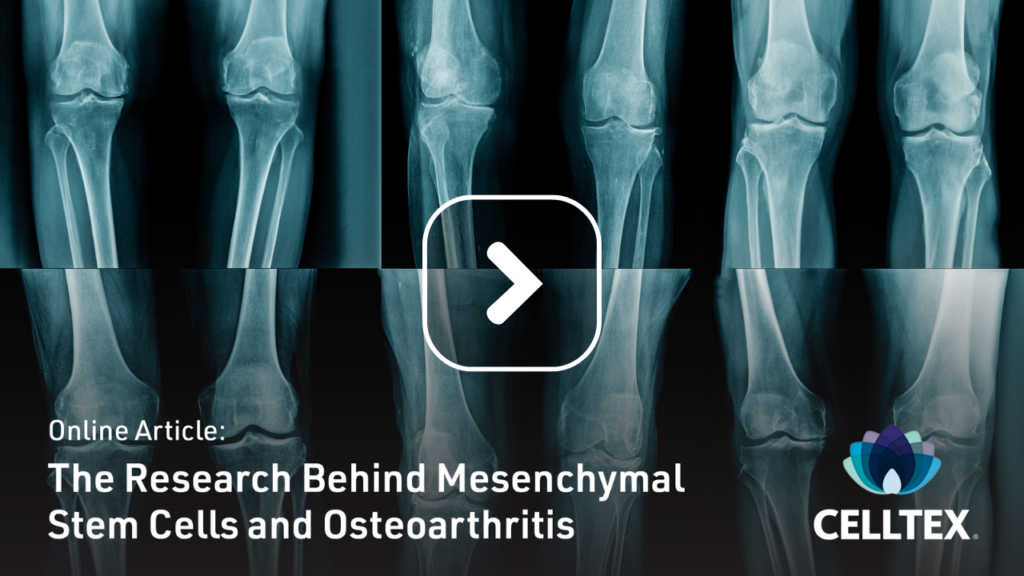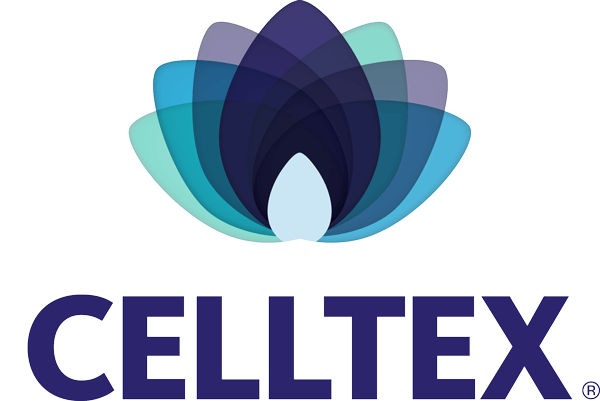Celltex News
Stem Cell Therapy: How Are MSCs Administered to the Body?

If there’s any doubt about the potential of stem cell therapy to revolutionize medicine, consider some headlines from earlier this year:
- “Chinese scientists cure diabetes using stem cells in world first”
- “Stem Cell Therapy Improves Post-Stroke Motor Function”
- “Preclinical Study Finds Novel Stem Cell Therapy Boosts Neural Repair After Cardiac Arrest”
Despite the exciting headlines, scientists and physicians are still learning about stem cell therapy and the routes of delivery used to administer it.
Through the years, several stem cell therapy delivery methods have emerged. Let’s discuss some of the common routes of administration physicians may recommend today.
Intravenous (IV) Infusion
Physicians often recommend IV infusions—regardless of one’s condition or health status—because they allow MSCs to travel via the circulatory system and regulate inflammation systemically.
Through a process called homing, MSCs can migrate to sites of injury or inflammation once administered into the body. These injured or inflamed areas emit pro-inflammatory and other signals that attract the MSCs to the site. [1]
Once at these sites, the MSCs may interact with cells at the site, release bioactive molecules, or recruit other cells to the site to help remediate the issue—be that to reduce inflammation, promote healing, or undergo differentiation.
In a recent webinar, we gathered a panel of regenerative medicine physicians to discuss stem cell therapy. During the discussion, Dr. Gabriel Salazar—an administering physician at Hospital Galenia in Cancun, Mexico—explained the process of homing:
“When we get stem cells through the venous system, these cells will be delivered to all of [the] body. Remember that there is a process that we call homing. Mediated by biochemical signals, the cells will go straight to the sites they are needed because the chronic inflammation is emitting signals.”
Intraarticular Injection
This administration method is used to address problematic joints, be it a knee, shoulder, hip, wrist, or finger. MSCs are injected inside the joint capsule to help regenerate cartilage tissue and regulate inflammation by communicating with local cells.
According to Dr. Miguel Ramirez—an orthopedic surgeon and administering physician at Hospital Galenia in Cancun, Mexico—conditions such as osteoarthritis, rheumatoid arthritis, post-fracture complications, and joint trauma may be mitigated via intraarticular MSC injection.
A 2019 clinical trial published in Stem Cells Translational Medicine examined the effects of an intraarticular injection of autologous adipose-derived MSCs on osteoarthritis of the knee. The study found that the MSCs provided functional improvement and pain relief within six months post treatment, without causing adverse events. [2]

Intradiscal Injection
This method is an injection into a spinal disc, generally the cervical (neck), thoracic (midback), or lumbar (lower back) spine. Fluoroscopy is used to ensure precise needle placement into the affected disc space.
Intradiscal injections may be recommended for conditions like degenerative disc disease (DDD) and herniated or bulging discs. Before receiving this method of stem cell administration, an MRI or CT scan is required to assess the condition of the discs and identify the target area.
Intradiscal stem cell injections have great potential for patients in which other treatment options have failed and/or do not provide enough relief. However, MSCs will not completely regenerate a problematic vertebral disc. Nonetheless, pain may be significantly reduced.
In the aforementioned panel discussion, Dr. Ramirez described this pain management goal:
“We deliver the cells specifically to the outer boundaries of the disc in order to provide that anti-inflammatory effect … One is not to expect to have a normal disc after this, but yes, for the pain to go away.”
A phase I clinical trial examined the safety and feasibility of injecting cultured MSC spheroids (which were pretreated with a protein to prime them towards enhanced cartilage regeneration) into spinal discs to treat chronic low back pain. Eight patients received a one-time injection of stem cells mixed with hyaluronic acid into their spinal discs. They were monitored for six months, using pain and disability scores and MRI scans to assess the outcomes. All patients completed the study without any adverse effects. Six patients showed significant improvements in pain and disability scores. While overall disc conditions didn’t drastically change, MRI scans showed positive changes in four patients, such as reduced disc protrusion. The study concluded that this method was safe and feasible for chronic low back pain. [3]
Intranasal Infusion
This non-invasive delivery method atomizes MSCs into the nasal passages, directly targeting the central nervous system (CNS). Primarily used for neurological conditions, intranasal infusions may help mitigate symptoms associated with Parkinson’s disease (PD), multiple sclerosis (MS), traumatic brain injury (TBI), and other CNS disorders.
Intranasal infusion is the only non-surgical administration method that delivers MSCs directly to the brain. The MSCs are administered through the nasal passages using a mucosal atomization device, often with the patient lying down to facilitate absorption. This method is thought to increase MSC access to the brain to quickly exert effects by bypassing the blood-brain barrier.
Recently, intranasal infusions have also been used to address secondary neurological symptoms and overall cognitive health.
During the physician panel discussion, Dr. Ana Camarillo—another administering physician at Hospital Galenia in Cancun, Mexico—mentioned that following intranasal therapy, many have reported “an improvement in cognitive functions, like attention, memory, and mental stress.”
In the future, additional studies are needed to confirm this method of stem cell administration for general cognitive health.
Intrathecal Injection
Given the nature of certain neurological conditions (such as MS or ALS) and spinal cord injuries, intrathecal injection may be an attractive delivery route for MSC therapy. In contrast to the intradiscal injections discussed above, intrathecal injections deliver the MSCs directly into the cerebrospinal fluid.
As Dr. Gabriel Salazar noted in the physician panel discussion, this method of stem cell administration is more invasive than some of the other routes of delivery:
“So, it’s a major procedure, of course it is, because we need to use a spinal anesthetic procedure … This is performed by an anesthesiologist that is an expert in that kind of protocol. Patients must be here at the hospital for at least six hours after the operation.”
A 2023 review published in Current Stem Cell Research & Therapy mentions that intrathecal injections of MSCs have shown efficacy for various neurological conditions, including MS, autism spectrum disorders, and TBI, among other conditions. Of the 39 studies included in the researchers’ analysis, none reported severe adverse events related to the intrathecal administration of MSCs. This led the researchers to conclude, “Properly performed spinal intrathecal injection of MSCs is exceedingly safe, with no serious adverse events reported based on our exhaustive literature search.” [4]
Intradermal Injection
Intradermal injections are primarily used in dermatology and cosmetic medicine, focusing on skin rejuvenation. This method may help reduce signs of aging, such as fine lines, wrinkles, and sagging skin. MSCs injected into the skin may help stimulate collagen production, improve skin elasticity, and enhance skin texture.
In addition, intradermal injections of MSCs into the scalp have shown promise to help promote hair growth and improve hair thickness. [5]
Beyond the aesthetic and cosmetic applications, intradermal injections are being investigated for other skin conditions. This includes autoimmune skin conditions such as psoriasis, eczema, vitiligo, androgenetic alopecia and alopecia areata; scars such as those caused by acne and surgical procedures; and wounds such as diabetic ulcers and pressure sores. [6]
In a 2023 study published in the Journal of Personalized Medicine, eight patients received intradermal injections of 100 million MSCs derived from their adipose tissue. All eight cases resulted in the shallowing and disappearance of wrinkles, including those of the glabella, the lower eyelids, crow’s feet, forehead, and nasolabial grooves (aka ‘smile lines’ at the corners of the mouth). Facial pores were significantly reduced as well in the patients. These positive treatment effects were present one year after the MSC administration. [7]
Nebulizer Infusion
With this route of administration, stem cells are aerosolized into a fine mist (using a nebulizer) and inhaled, directly targeting the respiratory system.
Nebulizer infusion protocols were designed for respiratory conditions like COPD, pneumonia, pulmonary fibrosis, asthma, acute respiratory distress syndrome (ARDS), Cystic Fibrosis, severe allergies, and chronic bronchitis.
In a 2021 article published in the Journal of Extracellular Vesicles, researchers investigated the effects of nebulizing human adipose-derived MSC extracellular vesicles as a pre-clinical treatment for lung injuries. The researchers first tested the treatment on mice with bacteria-induced lung injuries. The results showed that the treatment improved survival rates and reduced lung inflammation in the mice. Next, they evaluated the safety of the treatment by administering it to healthy human volunteers. The volunteers tolerated the treatment well without experiencing any serious side effects. These findings suggest that this approach holds promise as a strategy for lung injuries and warrants further exploration in clinical settings. [8]
IV Infusion + Injection: Dual Method of Stem Cell Therapy Plans
In addition to the single administration routes discussed above, a stem cell therapy plan may include a combination of delivery methods to better address the health issue. In general, administering physicians may combine IV infusion(s) with a targeted delivery route (intraarticular, intradiscal, etc.) for this approach.
Why the dual approach? For example, if someone has arthritis in the knee, why not only receive an injection directly into the knee?
In the aforementioned panel discussion, Dr. Miguel Ramirez explained the primary reason for the dual-method approach:
“You get the IV to saturate the system, and that covers all our subclinical presentations … But if we are targeting joint conditions, we want to spare [the stem cells] that trip and focus on target areas … We actually do the injection and deliver some extra cells inside the joint space, be it the knee, the hip, shoulder, elbows, wrist, fingers even.”
But how effective is this dual-method approach? Research is promising, albeit in the early stages.
In a 2022 phase I clinical trial published in Frontiers in Cardiovascular Medicine, researchers investigated the safety and feasibility of combining an intracoronary injection and an IV delivery of MSCs in patients with acute myocardial infarction. The study found that this dual-route administration was safe and can potentially improve cardiac function, suggesting that combining different delivery methods might enhance the therapeutic outcomes of stem cell therapy. [9]

The Celltex Process: High Doses of Mesenchymal Stem Cells
Celltex Therapeutics has taken regenerative medicine a step further through the process of Adult Stem Cell Banking.
Celltex’s technology enables an individual’s banked MSCs to be expanded into quantities exponentially greater than that of other regenerative medicine offerings, greatly increasing the potential for positive results when therapeutic application is necessary.
This difference in cell quantity, along with the compatibility from using one’s own cells contributes to the superior quality of Celltex-produced MSCs. Celltex-produced MSCs have the potential to succeed where other stem cell therapies may have failed before.
Learn More About Celltex
Celltex Therapeutics is a biotechnology company with the unique ability to do what no one else can: isolate, expand, and cryopreserve your own MSCs to create a stem cell bank from a single sample of your adipose tissue. Celltex-cultured MSCs have been used in over 10,000 stem cell therapies with no severe adverse events.
Interested in learning more about Celltex Adult Stem Cell Banking? Request a virtual brochure, watch our educational webinars, or contact us directly.
If you’re in the Houston area, you can schedule a tour of our lab in person or tour it virtually.
References:
- Yagi, H., Soto-Gutierrez, A., Parekkadan, B., Kitagawa, Y., Tompkins, R. G., Kobayashi, N., & Yarmush, M. L. (2010). Mesenchymal stem cells: Mechanisms of immunomodulation and homing. Cell transplantation, 19(6), 667–679. https://doi.org/10.3727/096368910X508762
- Lee, W. S., Kim, H. J., Kim, K. I., Kim, G. B., & Jin, W. (2019). Intra-Articular Injection of Autologous Adipose Tissue-Derived Mesenchymal Stem Cells for the Treatment of Knee Osteoarthritis: A Phase IIb, Randomized, Placebo-Controlled Clinical Trial. Stem cells translational medicine, 8(6), 504–511. https://doi.org/10.1002/sctm.18-0122
- Lee, D. H., Park, K. S., Shin, H. E., Kim, S. B., Choi, H., An, S. B., Choi, H., Kim, J. P., & Han, I. (2023). Safety and Feasibility of Intradiscal Administration of Matrilin-3-Primed Adipose-Derived Mesenchymal Stromal Cell Spheroids for Chronic Discogenic Low Back Pain: Phase 1 Clinical Trial. International journal of molecular sciences, 24(23), 16827. https://doi.org/10.3390/ijms242316827
- Barmada, A., Sharan, J., Band, N., & Prodromos, C. (2022). Serious adverse events have not been reported with spinal intrathecal injection of mesenchymal stem cells: A systematic review. Current Stem Cell Research & Therapy, 18(6), 829–833. https://doi.org/10.2174/1574888×17666220817125324
- Czarnecka, A., Odziomek, A., Murzyn, M., Dubis, J., Bagłaj-Oleszczuk, M., & Hryncewicz-Gwóźdź, A. (2021). Wharton’s jelly-derived mesenchymal stem cells in the treatment of four patients with alopecia areata. Advances in clinical and experimental medicine : official organ Wroclaw Medical University, 30(2), 211–218. https://doi.org/10.17219/acem/132069
- Sierra-Sánchez, Á., Montero-Vilchez, T., Quiñones-Vico, M. I., Sanchez-Diaz, M., & Arias-Santiago, S. (2021). Current Advanced Therapies Based on Human Mesenchymal Stem Cells for Skin Diseases. Frontiers in cell and developmental biology, 9, 643125. https://doi.org/10.3389/fcell.2021.643125
- Ichihashi, M., Tanaka, M., Iizuka, T., Totsuka, H., Tominaga, E., Hitomi, Y., Ando, H., Nishikata, T., & Mizutani, K. I. (2023). A Single Intradermal Injection of Autologous Adipose-Tissue-Derived Stem Cells Rejuvenates Aged Skin and Sharpens Double Eyelids. Journal of personalized medicine, 13(7), 1162. https://doi.org/10.3390/jpm13071162
- Shi, M. M., Yang, Q. Y., Monsel, A., Yan, J. Y., Dai, C. X., Zhao, J. Y., Shi, G. C., Zhou, M., Zhu, X. M., Li, S. K., Li, P., Wang, J., Li, M., Lei, J. G., Xu, D., Zhu, Y. G., & Qu, J. M. (2021). Preclinical efficacy and clinical safety of clinical-grade nebulized allogenic adipose mesenchymal stromal cells-derived extracellular vesicles. Journal of extracellular vesicles, 10(10), e12134. https://doi.org/10.1002/jev2.12134
- Hsiao, L.-C., Lin, Y.-N., Shyu, W.-C., Ho, M., Lu, C.-R., Chang, S.-S., Wang, Y.-C., Chen, J.-Y., Lu, S.-Y., Wu, M.-Y., Li, K.-Y., Lin, Y.-K., Tseng, W.-Y. I., Su, M.-Y., Hsu, C.-T., Tsai, C.-K., Chiu, L.-T., Chen, C.-L., Lin, C.-L., … Jeng, L.-B. (2022). First-in-human pilot trial of combined intracoronary and intravenous mesenchymal stem cell therapy in acute myocardial infarction. Frontiers in Cardiovascular Medicine, 9. https://doi.org/10.3389/fcvm.2022.961920
Post Tags: adult stem cell therapy, clinical research, medical research, stem cell banking, stem cell therapy
More Recent News
Exploring Regenerative Medicine Beyond Stem Cell Therapy
For many, stem cell therapy is to regenerative medicine what Google is to internet searches. Yet, there are other procedures within the regenerative medicine field that may be recommended depending on the health concern being addressed.
In this article, we explore several regenerative medicine options, including platelet-rich plasma (PRP), bone marrow aspirate concentrate (BMAC), stromal vascular fraction (SVF), and exosomes.
Read MoreWhat Makes MSCs So Promising? A Deep Dive on Mesenchymal Stem Cells
Present in the body throughout one’s lifespan, adult Mesenchymal Stem Cells (MSCs) can be used in many types of regenerative medicine. This article explores how MSCs work in the body and what makes them suitable for therapeutic application.
Read More
